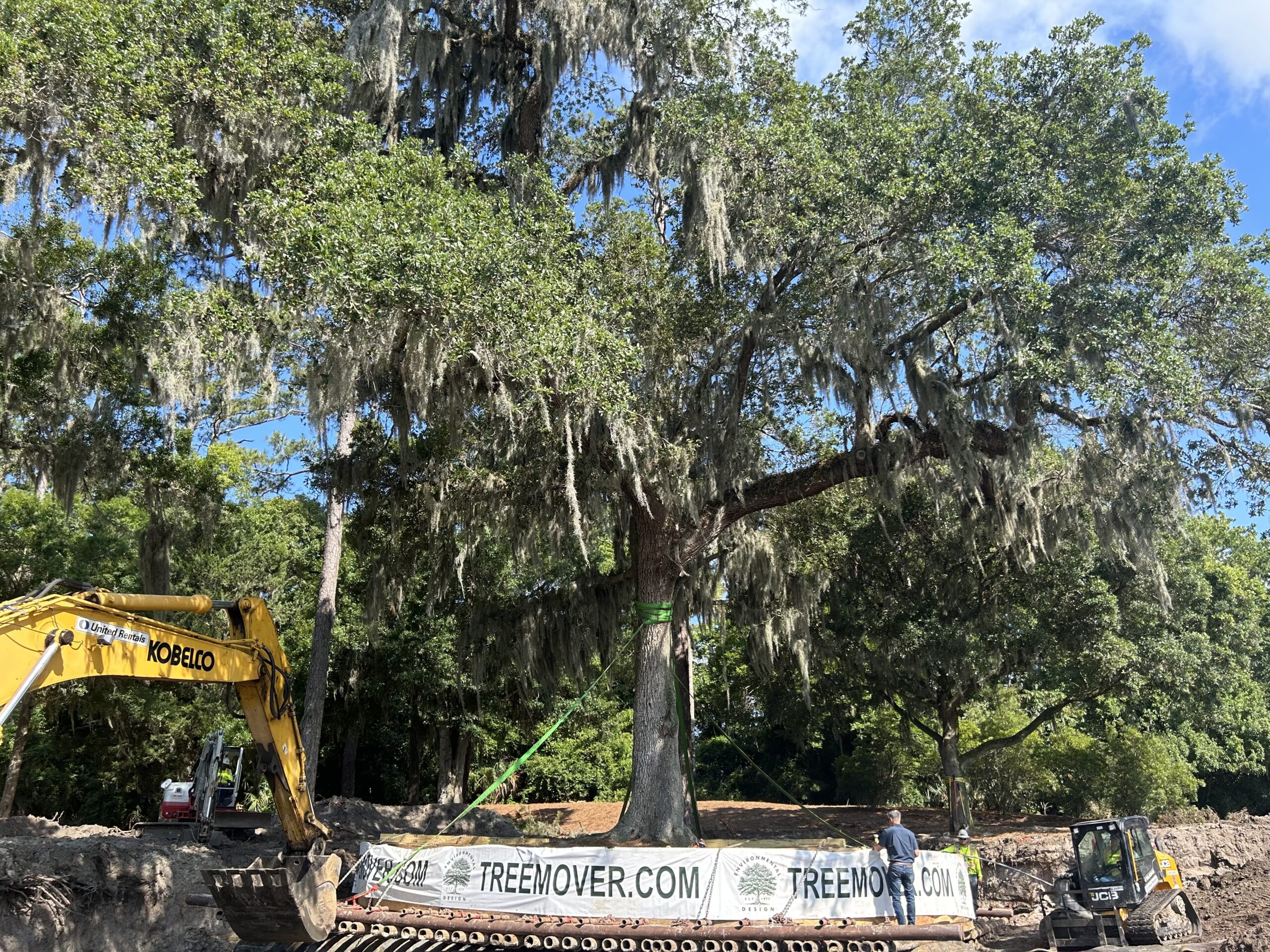What does it take to move half a million pounds of living history?
At Environmental Design Inc., that question isn’t rhetorical — it’s a challenge we proudly accepted. When TPC Sawgrass sought to restore one of its most symbolic course elements — the towering live oak that once loomed over the sixth tee — they turned to the experts in large tree relocation. That tree had long shaped the psychology of the hole, haunting even the best players’ swings. After its removal in 2014 due to disease, a void was left in the spirit of Pete Dye’s original course design.
Bringing it back required vision, precision, and a deep respect for what the tree represented.
As leaders in large tree transplanting, Environmental Design Inc. specializes in turning once-impossible ideas into reality. With over 40 years of experience and patented techniques like ArborLift®, our work bridges natural legacy with modern ingenuity.
This blog takes you behind the scenes of the TPC Sawgrass transplant — from identifying the perfect tree to executing one of the most technically challenging moves in golf course history. It’s a story of ingenuity, history, and honoring the mental architecture that defines one of the sport’s most iconic holes.
Finding the Right Tree for the Right Legacy
Honoring a Course Designer’s Vision
TPC Sawgrass is more than a golf course — it’s a psychological maze crafted by one of golf’s most revered designers, Pete Dye. The live oak that overhung the sixth tee wasn’t an accident of nature. Dye left it there intentionally, not as a physical barrier, but as a psychological one. It didn’t block the fairway so much as it challenged the mind.
For years, the tree earned a reputation. Some players feared it. Others hated it. A few, like Davis Love III, made it a running joke to ask the commissioner when it would finally be cut down. Yet despite the complaints, it became a symbol of the course’s character. When disease forced its removal in 2014, the sixth hole lost more than an obstacle — it lost its identity.
Discovery Just Yards Away
Fast forward nearly a decade. In a wooded section just 100 yards down the fairway, a near mirror image of the original tree was found — a mature live oak with similar height, spread, and character. It was more than luck; it was an opportunity.
With the support of PGA Tour leadership and course architects, the decision was made to restore the psychological essence of the sixth hole by relocating this tree. But to do it right, the job required a team with a deep understanding of tree biology and the logistics of moving something so massive.
Planning a Precision Relocation
Engineering the Impossible
Moving a tree with a 45-foot root ball and a weight exceeding 500,000 pounds is no small feat. The risk of damaging the tree or the course was high. Every aspect of the relocation needed to be analyzed: soil condition, root health, structural integrity, and optimal timing. That’s where our decades of experience made all the difference.
Leveraging ArborLift® Technology
Using our patented ArborLift® system, we lifted the tree with minimal disturbance. Large inflatable pneumatic platforms were inserted under the root ball, creating a cushion that allowed for gradual elevation. This proprietary method is critical in preserving root mass and preventing transplant shock — a major factor in long-term survivability.
Timing and Coordination
Our process is highly coordinated. Digging began in early summer, followed by days of careful preparation. With the site pre-dug and staging zones clearly defined, we navigated the tree slowly across the landscape using excavators and rolling airbag systems. Every movement was measured. Every potential complication had a backup plan.
The Move
A Slow, Powerful Journey
The actual move took place at a crawl — by design. Trees of this size can’t simply be lifted and carried. They must be coaxed. Stabilized. Guided. Like rolling a ship to water, the tree was slowly moved into position using a combination of rolling bags and hydraulic lifts.
Placement and Orientation
Placement was more than a matter of position. It was about restoring presence. We worked closely with TPC Sawgrass officials to ensure the tree’s alignment mimicked the original — capturing the same angles, shadows, and psychological tension. The tree doesn’t just stand near the tee; it watches over it.
Immediate Post-Planting Support
After planting, we initiated our aftercare protocol. That included customized irrigation solutions, anchoring systems, and ongoing root monitoring. Our goal was not just survival, but vibrancy — to ensure the tree could live, grow, and once again challenge the best golfers in the world.
Emotional and Competitive Impact
Players React in Real Time
The reactions from the PGA Tour community were swift — and divided. Some players embraced the return of the tree with nostalgia. Others, especially high-ball hitters, saw it as a renewed challenge. Rory McIlroy called it an improvement. Keith Mitchell, after a failed attempt to drive under it, simply called it “dicey.”
It was, in every sense, the return of a character — not just a tree.
A Conversation Piece and a Statement
For fans and players alike, the restored tree has become a focal point of conversation. Some laugh. Some complain. But no one ignores it. And that’s exactly the point. Just like Pete Dye intended, the tree now lives as a mental landmark as much as a physical one.
Technical Challenges and Solutions
Preserving Root Structure
Root pruning, health assessments, and air spading were used to prepare the tree prior to relocation. These steps were critical in maintaining root integrity and giving the tree the best chance at establishing itself quickly.
Customized Equipment for Unusual Terrain
This wasn’t a flat site. The course’s undulations required customized rigging and precise control over every angle of the move. Our engineering team adapted existing ArborLift® rigs for the course’s geography — adding further stability and control.
Environmental and Long-Term Care
Ecological Sensitivity
Our process ensured minimal disruption to surrounding vegetation. Protective mats, biodegradable stabilization materials, and environmentally conscious timing helped preserve the integrity of the landscape.
Follow-Up Maintenance
We didn’t leave after planting. Our follow-up program includes moisture monitoring, root zone inspections, and nutrient treatments tailored to the specific microclimate of the course. The health of this tree remains a living measure of project success.
Reflecting on a Living Legacy
A Symbol of Golf’s Heritage
What was once seen as an annoyance is now remembered as a signature. The tree’s rebirth at TPC Sawgrass proves that legacy matters — and that with the right partners, even nature can be reimagined without losing its roots.
Setting a New Standard
This project is now a case study in how thoughtful tree relocation can intersect with sports history, landscape architecture, and environmental stewardship. It’s not just a win for EDI — it’s a win for the game.
Conclusion
The relocation of the iconic oak at TPC Sawgrass wasn’t about removing a tree. It was about reintroducing a presence — one that speaks to design, challenge, and memory. Environmental Design Inc. is proud to have played a central role in bringing it back to life, where it continues to test the best in the game.
From vision to execution, this project represents what’s possible when passion meets precision.
Environmental Design, Inc
At Environmental Design Inc., we move more than trees — we move legacies. With over four decades of experience, patented ArborLift® technology, and a team committed to excellence, we turn complex projects into living success stories. Whether you’re restoring history or shaping a new future, we’re here to help you do it right.
Explore our projects or contact us today to schedule your consultation.
Let’s move something extraordinary — together.




Recent Comments